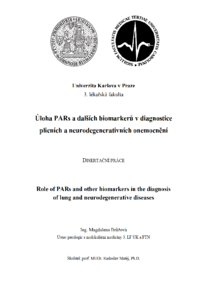Úloha PARs a dalších biomarkerů v diagnostice plicních a neurodegenerativních onemocnění
Role of PARs and other biomarkers in the diagnosis of lung and neurodegenerative diseases
dizertační práce (OBHÁJENO)

Zobrazit/
Trvalý odkaz
http://hdl.handle.net/20.500.11956/174302Identifikátory
SIS: 174665
Kolekce
- Kvalifikační práce [3146]
Autor
Vedoucí práce
Oponent práce
Němejcová, Kristýna
Škarda, Jozef
Fakulta / součást
3. lékařská fakulta
Obor
Biologie a patologie buňky
Katedra / ústav / klinika
Ústav patologie 3. LF UK a FNKV
Datum obhajoby
16. 6. 2022
Nakladatel
Univerzita Karlova, 3. lékařská fakultaJazyk
Čeština
Známka
Prospěl/a
1 SOUHRN Výzkum biomarkerů je v posledních letech předmětem mnoha studií, které se zabývají etiopatogenetickými procesy různorodých onemocnění. Nalezení takového biomarkeru, který by odrážel patologické procesy daného onemocnění s vysokou senzitivitou i specificitou a byl jednoduše dostupný a stabilní, by velmi usnadnilo diagnostiku těch onemocnění, která není snadné běžnými vyšetřovacími způsoby rozlišit. Intersticiální plicní procesy (IPP) zahrnují heterogenní skupinu poruch většinou zánětlivé povahy. Výsledné poškození plicního parenchymu může vést k jeho remodelaci a fibrotizaci. Fibroproliferativní proces může u různých typů IPP vyústit v podobné klinické projevy a nálezy na radiologických snímcích a v bioptických vzorcích, což ztěžuje diferenciální diagnostiku. Výzkumy se proto v této problematice orientují na přítomnost biomarkerů v tekutině získané bronchoalveolární laváží (BALT) za účelem určit hladiny biomarkerů specifické pro jednotlivé IPP. Analýza BALT je používána pro diferenciální diagnostiku pacientů s IPP, může však být také využita pro monitorování průběhu nemoci, příp. odpovídavosti na léčbu. V naší první studii jsme porovnávali hladiny biomarkerů v BALT u pacientů se sarkoidózou a hypersenzitivní pneumonií (HP). Z výsledků studie lze usuzovat, že by proteinázou aktivovaný receptor...
1 SUMMARY In recent years, biomarker research has been the subject of many studies that address the etiopathogenetic processes of various diseases. Finding a biomarker that reflects the pathological processes of the disease with high sensitivity and specificity and was easily available and stable, would greatly facilitate the diagnosis of those diseases that are not easy to distinguish by conventional screening methods. Interstitial lung diseases (ILDs) include a heterogeneous group of disorders mostly of inflammatory nature. The resulting damage of the lung parenchyma can lead to its remodeling and fibrotization. The fibroproliferative process in different types of ILDs can result in similar clinical manifestations and findings on radiological images and biopsy specimens, which makes differential diagnosis difficult. Therefore, research in this area focuses on the presence of biomarkers in bronchoalveolar lavage fluid (BALF) to determine biomarker levels specific to individual ILDs. BALF analysis is used for differential diagnosis of patients with ILDs, but it can also be used to monitor the course of the disease, or response to the treatment. In our first study, we compared the levels of biomarkers in BALF in patients with sarcoidosis and hypersensitivity pneumonia (HP). From the results of the study, it...
